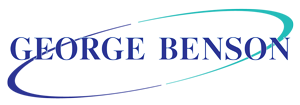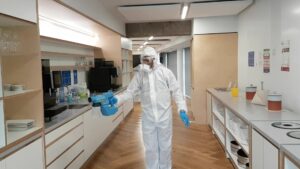Overview
Fogging introduces a fine chemical mist into the air reducing the risk of airborne or surface contamination, the process has been widely used commercially for many years as odour, contamination and pest control. Many articles from the cleaning industry about Covid-19 claim their processes or products will all but eradicate the virus. This prompted us to embark on a detailed development program to identify potential hazards and establish evidence as to the effectiveness of fogging against Covid-19 and, of course, to justify costs.
Hazards – Humidity
Control of humidity in an office environment is important, not only for our general health, but also for the building fabric, IT equipment etc.. Acceptable humidity levels are between 40-60% with anything greater being a risk and ‘Fogging’ by its nature adds moisture into the air. The equipment we use expels a bactericide as a fine mist of 40 microns at a controlled rate of 750ml per hour covering an area of approximately 400 square metres. Test results showed a maximum increase in humidity of between 4-6% at this controlled rate.
Hazards – Chemical & COSHH
When ‘Fogging’ the use of the correct sanitising chemical is essential to ensure effectiveness against most known viruses as well as other pathogens. Most sanitisers available will remove all but 0.001% of known pathogens. However many of these chemicals have high alkalinity levels hence without a secondary neutralising process, could result in long term damage on surfaces such as laminated, plastics, metals and in particular, soft furnishings.
Method
To prove out the effectiveness of our ‘Fogging’ process we applied ‘ATP Swab Testing’ which is a standard within the healthcare and catering industries. ‘ATP’ stands for ‘Adenosine Triphosphate’ which is an organic compound found in all living cells, this is measured using a bioluminescence enzyme, whereby light is generated in amounts proportional to the concentration of ATP in swabbed samples. Thus by testing for ‘ATP’ before and after cleaning, then again after ‘Fogging’ we can identify the effectiveness of the total decontamination process.
Results
Our ATP monitoring system is ‘Hygiena Systemsure’ which uses a handheld luminaire meter to measure ATP activity on swabbed samples on a scale determined by its RLU (relative light units) value. The development program showed that this testing process proves out the effectiveness of our company’s existing cleaning service, together with the added virus controls gained from the ‘Fogging’ process.
Hazards – Humidity – Taking a humidity reading before ‘fogging’ is essential to ensure you do not exceed the standard limits. (Test results available on request)
Hazards – Chemical & COSHH – The industry standard for testing the effectiveness of a bactericide against known viruses such as MRSA. Norovirus, Listeria etc. is BS EN 1276 and BS EN 14476. Despite many claims no product laboratory report categorically stated a chemical is proven to be effective against Covid-19, which is not surprising.
After extensive trials we found ‘Virosol’ to be the safest and most effective sanitising chemical for killing all but 0.001% of known viruses and bacteria, leaving no tangible residue and hence not requiring a neutralising process.
Fogging
‘Fogging’ as a stand-alone service is in general around 15% effective on most non-porous surfaces such as desks, kitchen areas, handles, taps etc., however, porous surfaces such as fabric upholstery and carpets responded much better with almost a 50% reduction in contaminants.
Cleaning – It is essential there is an effective cleaning program in place before ‘Fogging’ In order to achieve the best results from the process. The ‘Fogging’ will then reach areas of a building which are not easily cleaned, such as ceilings, tiny gaps between desks, fabrics, and hidden crevices. The fine mist introduced remains airborne for around 15-20 minutes thus eliminating any lingering pathogens. ‘Fogging’ adds the final touch to a good basic cleaning and disinfecting program, giving reassurance that under current cleaning guidelines you have done everything possible to protect your personnel.
ATP Testing – Verification Guide & Swab test results available on request – An office or room may look and smell clean, but how clean is it really? The ATP testing service we offer provides quantifiable data on the effectiveness of the cleaning regime in your building to a recognised healthcare benchmark.
Check out the complete process Click Video Link – VIDEO George Benson Ltd Fogging & ATP Swab Testing
Please contact us on 01708 454535 or info@georgebenson.co.uk for further information

